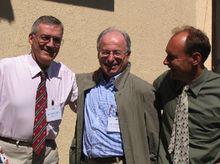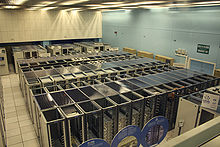
World Wide Web
Background Information
SOS Children volunteers helped choose articles and made other curriculum material Sponsor a child to make a real difference.
 The Web's logo designed by Robert Cailliau |
|
| Inventor | Tim Berners-Lee Robert Cailliau |
|---|---|
| Company | CERN |
| Availability | Worldwide |
| Internet |
|---|
 An Opte Project visualization of routing paths through a portion of the Internet.
|
|
General
|
|
Governance
|
|
Information infrastructure
|
|
Guides
|
The World Wide Web (abbreviated as WWW or W3, commonly known as the Web), is a system of interlinked hypertext documents accessed via the Internet. With a web browser, one can view web pages that may contain text, images, videos, and other multimedia, and navigate between them via hyperlinks.
Using concepts from his earlier hypertext systems like ENQUIRE, British engineer, computer scientist and at that time employee of CERN, Sir Tim Berners-Lee, now Director of the World Wide Web Consortium (W3C), wrote a proposal in March 1989 for what would eventually become the World Wide Web. At CERN, a European research organisation near Geneva situated on Swiss and French soil, Berners-Lee and Belgian computer scientist Robert Cailliau proposed in 1990 to use hypertext "to link and access information of various kinds as a web of nodes in which the user can browse at will", and they publicly introduced the project in December of the same year.
History
In the May 1970 issue of Popular Science magazine, Arthur C. Clarke predicted that satellites would someday "bring the accumulated knowledge of the world to your fingertips" using a console that would combine the functionality of the photocopier, telephone, television and a small computer, allowing data transfer and video conferencing around the globe.
In March 1989, Tim Berners-Lee wrote a proposal that referenced ENQUIRE, a database and software project he had built in 1980, and described a more elaborate information management system.
With help from Robert Cailliau, he published a more formal proposal (on 12 November 1990) to build a "Hypertext project" called "WorldWideWeb" (one word, also "W3") as a "web" of "hypertext documents" to be viewed by " browsers" using a client–server architecture. This proposal estimated that a read-only web would be developed within three months and that it would take six months to achieve "the creation of new links and new material by readers, [so that] authorship becomes universal" as well as "the automatic notification of a reader when new material of interest to him/her has become available." While the read-only goal was met, accessible authorship of web content took longer to mature, with the wiki concept, blogs, Web 2.0 and RSS/ Atom.
The proposal was modeled after the Dynatext SGML reader by Electronic Book Technology, a spin-off from the Institute for Research in Information and Scholarship at Brown University. The Dynatext system, licensed by CERN, was technically advanced and was a key player in the extension of SGML ISO 8879:1986 to Hypermedia within HyTime, but it was considered too expensive and had an inappropriate licensing policy for use in the general high energy physics community, namely a fee for each document and each document alteration.
A NeXT Computer was used by Berners-Lee as the world's first web server and also to write the first web browser, WorldWideWeb, in 1990. By Christmas 1990, Berners-Lee had built all the tools necessary for a working Web: the first web browser (which was a web editor as well); the first web server; and the first web pages, which described the project itself. On 6 August 1991, he posted a short summary of the World Wide Web project on the alt.hypertext newsgroup. This date also marked the debut of the Web as a publicly available service on the Internet. Many newsmedia have reported that the first photo on the web was uploaded by Berners-Lee in 1992, an image of the CERN house band Les Horribles Cernettes taken by Silvano de Gennaro; Gennaro has disclaimed this story, writing that media were "totally distorting our words for the sake of cheap sensationalism." The first server outside Europe was set up at the Stanford Linear Accelerator Centre (SLAC) in Palo Alto, California, to host the SPIRES-HEP database. Accounts differ substantially as to the date of this event. The World Wide Web Consortium says December 1992, whereas SLAC itself claims 1991. This is supported by a W3C document titled A Little History of the World Wide Web.
The crucial underlying concept of hypertext originated with older projects from the 1960s, such as the Hypertext Editing System (HES) at Brown University, Ted Nelson's Project Xanadu, and Douglas Engelbart's oN-Line System (NLS). Both Nelson and Engelbart were in turn inspired by Vannevar Bush's microfilm-based " memex", which was described in the 1945 essay " As We May Think".
Berners-Lee's breakthrough was to marry hypertext to the Internet. In his book Weaving The Web, he explains that he had repeatedly suggested that a marriage between the two technologies was possible to members of both technical communities, but when no one took up his invitation, he finally tackled the project himself. In the process, he developed three essential technologies:
- a system of globally unique identifiers for resources on the Web and elsewhere, the universal document identifier (UDI), later known as uniform resource locator (URL) and uniform resource identifier (URI);
- the publishing language HyperText Markup Language (HTML);
- the Hypertext Transfer Protocol (HTTP).
The World Wide Web had a number of differences from other hypertext systems that were then available. The Web required only unidirectional links rather than bidirectional ones. This made it possible for someone to link to another resource without action by the owner of that resource. It also significantly reduced the difficulty of implementing web servers and browsers (in comparison to earlier systems), but in turn presented the chronic problem of link rot. Unlike predecessors such as HyperCard, the World Wide Web was non-proprietary, making it possible to develop servers and clients independently and to add extensions without licensing restrictions. On 30 April 1993, CERN announced that the World Wide Web would be free to anyone, with no fees due. Coming two months after the announcement that the server implementation of the Gopher protocol was no longer free to use, this produced a rapid shift away from Gopher and towards the Web. An early popular web browser was ViolaWWW for Unix and the X Windowing System.

Scholars generally agree that a turning point for the World Wide Web began with the introduction of the Mosaic web browser in 1993, a graphical browser developed by a team at the National Centre for Supercomputing Applications at the University of Illinois at Urbana-Champaign (NCSA-UIUC), led by Marc Andreessen. Funding for Mosaic came from the U.S. High-Performance Computing and Communications Initiative and the High Performance Computing and Communication Act of 1991, one of several computing developments initiated by U.S. Senator Al Gore. Prior to the release of Mosaic, graphics were not commonly mixed with text in web pages and the Web's popularity was less than older protocols in use over the Internet, such as Gopher and Wide Area Information Servers (WAIS). Mosaic's graphical user interface allowed the Web to become, by far, the most popular Internet protocol.
The World Wide Web Consortium (W3C) was founded by Tim Berners-Lee after he left the European Organization for Nuclear Research (CERN) in October 1994. It was founded at the Massachusetts Institute of Technology Laboratory for Computer Science (MIT/LCS) with support from the Defense Advanced Research Projects Agency (DARPA), which had pioneered the Internet; a year later, a second site was founded at INRIA (a French national computer research lab) with support from the European Commission DG InfSo; and in 1996, a third continental site was created in Japan at Keio University. By the end of 1994, while the total number of websites was still minute compared to present standards, quite a number of notable websites were already active, many of which are the precursors or inspiration for today's most popular services.
Connected by the existing Internet, other websites were created around the world, adding international standards for domain names and HTML. Since then, Berners-Lee has played an active role in guiding the development of web standards (such as the markup languages in which web pages are composed), and in recent years has advocated his vision of a Semantic Web. The World Wide Web enabled the spread of information over the Internet through an easy-to-use and flexible format. It thus played an important role in popularizing use of the Internet. Although the two terms are sometimes conflated in popular use, World Wide Web is not synonymous with Internet. The Web is a collection of documents and both client and server software using Internet protocols such as TCP/IP and HTTP. Tim Berners-Lee was knighted in 2004 by Queen Elizabeth II for his contribution to the World Wide Web.
Function
The terms Internet and World Wide Web are often used in everyday speech without much distinction. However, the Internet and the World Wide Web are not the same. The Internet is a global system of interconnected computer networks. In contrast, the Web is one of the services that runs on the Internet. It is a collection of text documents and other resources, linked by hyperlinks and URLs, usually accessed by web browsers from web servers. In short, the Web can be thought of as an application "running" on the Internet.
Viewing a web page on the World Wide Web normally begins either by typing the URL of the page into a web browser or by following a hyperlink to that page or resource. The web browser then initiates a series of communication messages, behind the scenes, in order to fetch and display it. As an example, consider accessing a page with the URL http://example.org/wiki/World_Wide_Web.
First, the browser resolves the server-name portion of the URL (example.org) into an Internet Protocol address using the globally distributed database known as the Domain Name System (DNS); this lookup returns an IP address such as 208.80.152.2. The browser then requests the resource by sending an HTTP request across the Internet to the computer at that particular address. It makes the request to a particular application port in the underlying Internet Protocol Suite so that the computer receiving the request can distinguish an HTTP request from other network protocols it may be servicing such as e-mail delivery; the HTTP protocol normally uses port 80. The content of the HTTP request can be as simple as the two lines of text
GET /wiki/World_Wide_Web HTTP/1.1 Host: example.org
The computer receiving the HTTP request delivers it to web server software listening for requests on port 80. If the web server can fulfill the request it sends an HTTP response back to the browser indicating success, which can be as simple as
HTTP/1.0 200 OK Content-Type: text/html; charset=UTF-8
followed by the content of the requested page. The Hypertext Markup Language for a basic web page looks like
We provide Linux to the World
SITEMAP
Make a donation: IBAN: IT36M0708677020000000008016 - BIC/SWIFT: ICRAITRRU60 - VALERIO DI STEFANO or
Privacy Policy Cookie Policy Terms and Conditions
The World Wide Web, abbreviated as WWW and commonly known ...
Our
"Network":
Project Gutenberg
https://gutenberg.classicistranieri.com
Encyclopaedia Britannica 1911
https://encyclopaediabritannica.classicistranieri.com
Librivox Audiobooks
https://librivox.classicistranieri.com
Linux Distributions
https://old.classicistranieri.com
Magnatune (MP3 Music)
https://magnatune.classicistranieri.com
Static Wikipedia (June 2008)
https://wikipedia.classicistranieri.com
Static Wikipedia (March 2008)
https://wikipedia2007.classicistranieri.com/mar2008/
Static Wikipedia (2007)
https://wikipedia2007.classicistranieri.com
Static Wikipedia (2006)
https://wikipedia2006.classicistranieri.com
Liber Liber
https://liberliber.classicistranieri.com
ZIM Files for Kiwix
https://zim.classicistranieri.com
Other Websites:
Bach - Goldberg Variations
https://www.goldbergvariations.org
Lazarillo de Tormes
https://www.lazarillodetormes.org
Madame Bovary
https://www.madamebovary.org
Il Fu Mattia Pascal
https://www.mattiapascal.it
The Voice in the Desert
https://www.thevoiceinthedesert.org
Confessione d'un amore fascista
https://www.amorefascista.it
Malinverno
https://www.malinverno.org
Debito formativo
https://www.debitoformativo.it
Adina Spire
https://www.adinaspire.com
The web browser parses the HTML, interpreting the markup (


